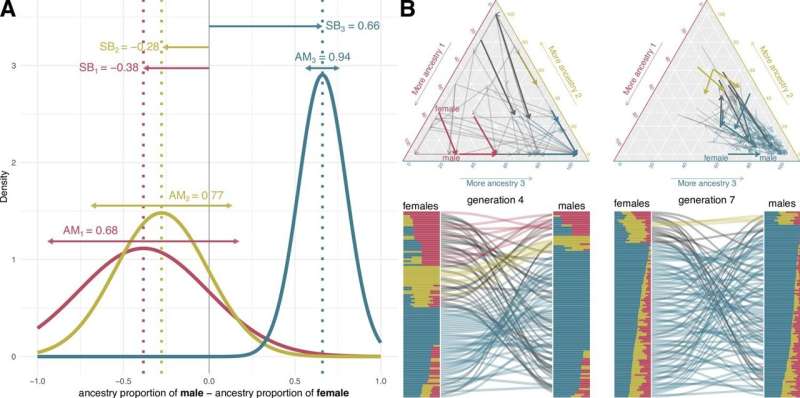This article has been reviewed according to Science X's editorial process and policies. Editors have highlighted the following attributes while ensuring the content's credibility:
fact-checked
peer-reviewed publication
trusted source
proofread
Study reveals genetic legacy of racial and gender hierarchies

Researchers from Queen Mary University of London have revealed how sociocultural factors, in addition to geography, play a significant role in shaping the genetic diversity of modern societies. The research published in eLife employed deep learning to unravel the intricate patterns of ancestry-related sex bias and assortative mating, revealing how societal structures have shaped the genetic diversity of the Americas region.
"Our study sheds light on how social stratification has woven its threads into the genetic fabric of admixed populations in the Americas," remarked Dr. Matteo Fumagalli, Senior Lecturer in Genetics at Queen Mary University of London. "For the first time, we used a mating model where the individual proportions of the genome inherited from Native American, European, and sub-Saharan African ancestries dictate the mating probabilities."
The researchers meticulously analyzed genetic data from hundreds of individuals across the Americas, revealing striking differences in mating patterns between Latin America and North America.
In Latin America, the proportion of Native American ancestry for both men and women was found to significantly influence mating probabilities, shaping the population's genetic composition. Conversely, in North America, sub-Saharan African ancestry played a more prominent role in determining mating choices.
Venturing into the depths of history, the researchers delved into the historical context, investigating how population stratification in the Americas was shaped by racial and gender hierarchies that have constrained the admixture processes since the European colonization and the subsequent Atlantic slave trade.
Their findings reveal that racial stratification intensified gender inequalities and that historically enforced mixing between social classes led to a dilution of non-European ancestry while not diminishing discrimination.
"The study's findings hold profound implications for our understanding of the historical and genetic tapestry of the Americas. They illuminate how social stratification, deeply rooted in racial and gender hierarchies, has left an indelible mark on the genetic diversity of these populations and shaped the genetic contours of these populations, leaving an enduring legacy," commented Dr. Matteo Fumagalli.
This study serves as a testament to the transformative power of AI in unraveling complex biological questions. By developing this deep learning model, the researchers were able to quantify the extent to which ancestry-driven mating has shaped the genomes of admixed societies. AI has allowed researchers to peer into the intricate details of the genetic landscape, revealing the profound impact of social forces on human diversity.
Looking beyond the Americas, the researchers envision their approach being applied to other admixed populations worldwide, furthering our understanding of how sociocultural factors have intertwined with geography to shape human genetic diversity. "Our approach has the potential to unlock the secrets of other admixed populations worldwide, furthering our understanding of how sociocultural factors have impacted the genetic tapestry of modern societies," stated Fumagalli.
More information: Alex Mas-Sandoval et al, The genomic footprint of social stratification in admixing American populations, eLife (2023). DOI: 10.7554/eLife.84429
Journal information: eLife
Provided by Queen Mary, University of London





















